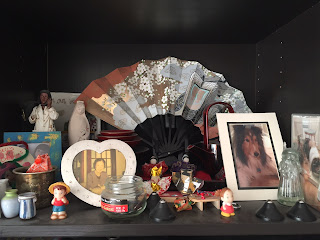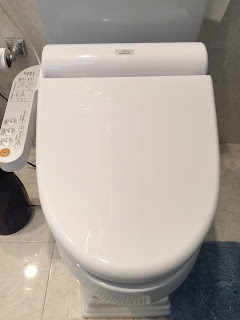Our family lives in America, but in many ways, we attempt to maintain some aspects of a Japanese household. From the outside, our home is almost stereotypically American, particularly for California. A moderate sized, ranch-style home with a front and back yard, built in the 1950s, you can't really get a more generically American home. But on the inside, there are a number of little tweaks we have made and practices we hold to that have made our home, at least in some ways, distinctly Japanese.
Let's start with the most commonly know practice: not wearing shoes in the home. Growing up with shoes on at all times, at first I found this a bit odd but have come to love it. The one drawback is that the space before your front door is always crammed with endless rows of shoes and baskets and house slippers.
The same goes for the back door, too!
Taking off shoes at the door may make a bit of a mess, and sometimes leads to some awkward conversations with friends who come over for the first time, but it definitely cuts down on the mud, dirt, dust and the constant vacuuming that come with it. And besides, not wearing shoes means you can slide around the wood floors in your socks!
Toys and nicknacks are another instance where our house is a bit different. While the kids have plenty of American toys, there are a number outliers that help to identify our household as Japanese. In Mimi's room, a koinobori (carp flag) that she made hangs proudly, waiting to be taken out on Children's Day.
Kuri has developed an obsession for train sets, particularly those made by Tomica in Japan. These sets create amazing little worlds for plastic engines and miniature cars. We started small...
...but these sets have a tendency to take on a life of their own. The exponential growth of Japanese train sets in our home is in no way related to Kuri's father's penchant for model trains and cars. That's just a vicious rumor.
Like all kids, Mimi, Kuri, and Mari have a wide arrangement of plush toys. But amongst the usual bears, horses, dogs, bunnies, and cats, you'll come across a cuddly UltraMan in our collection.
Our nicknack shelves even betray that this household has a bit of a Japanese bent. Sumie's, as one might expect, has plenty of Japanese items, including Japanese dolls, a tea set, and a fan.
But even mine, the shelf of a boy obsessed with Star Wars, has succumbed to a strong Japanese influence. Outside of Ben Kenobi, a few radio tubes, a tinker toy Land Rover, and an old CHiPs motorcycle, everything else is straight out of Japan.
Food and food prep tools are another way in which our household has a Japanese tinge. As I have found, no Japanese household is complete without a pot for boiling hot water for tea and a rice cooker, both of which are always readily available. Regarding the rice cooker, this will invariably be made by Zojirushi, National, or another Japanese manufacturer. Accept no substitutes.
With the rice cooker will come a massive storage box for rice, holding at least a 15lb bag. In most of these storage bins, just like ours, you'll find a cup that has given up its first job of holding liquids and has been relegated to scooping rice for the rest of its life.
A portable hot pot is another big item. Ours allows you to make nabe or do yakiniku (Japanese BBQ with thin meat) right at your own table. You'll need plenty of small plates on hand as well. Not as many as your would for a Korean meal, but still, small plates are a much needed commodity in a Japanese household.
When it comes time for school lunch, we don't brown bag-it. Mimi takes a bento each day.
And, from time-to-time, even our drink bottle caps get into the Japanese spirit.
When it comes to furniture, our place is a bit different, too. Instead of a trundle bed or an air mattress for extra guests, we have a slew of futons that can sleep four adults or ten kids.
There's at least one electronic item made by Sony...
...and at there's even an a Washlet to keep everything unmentionable clean.
Our favorite piece of Japanese furniture is perhaps the most unique. It's a kotatsu. As you can see, our coffee table is a little different. We removed the top and put a large blanket over the frame, then put the top back on. In a traditional kotatsu, there's a heater built into the table. For ours, we just bought a huge heated carpet, which does the trick quite nicely.
These tables are fantastic for cold nights as they hold in all the heat under the blanket. Mimi loves to cuddle up under it when she watches cartoons...
...and she likes to read her little brother stories when they're both nice and cozy.
Even Mari, who is still learning how to crawl, appreciates the cuddling that occurs when you have a kotatsu.
There are a number of other things in our home that are slightly out of the ordinary (I couldn't bring myself to show our collection of chopsticks), but for the most part, it's a home like any other here in the US. We just like to think we're trying to apply a bit from the best of both our worlds.




















No comments:
Post a Comment